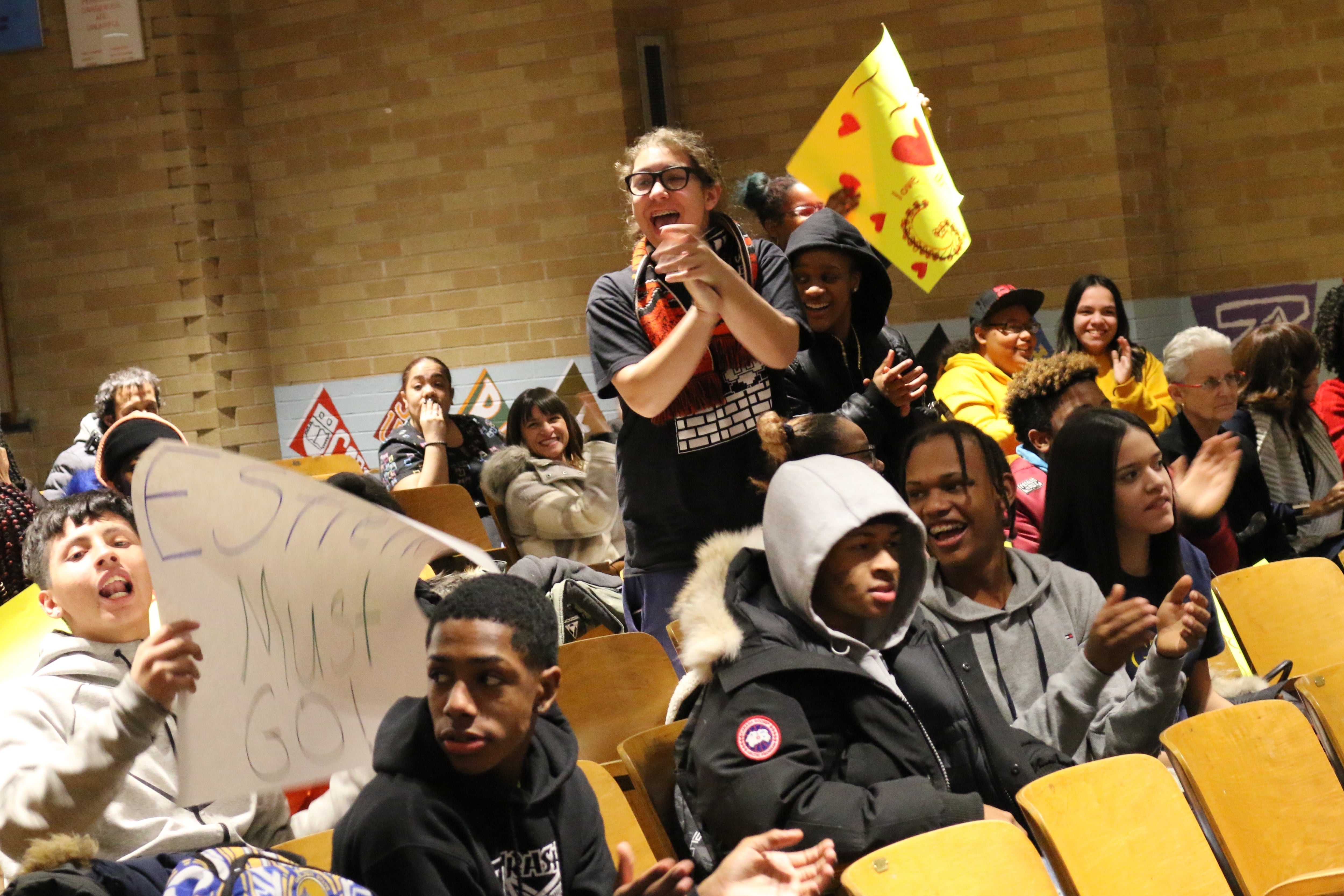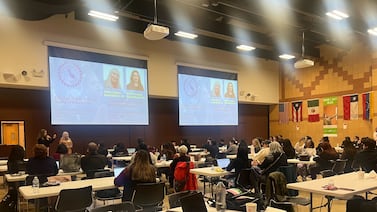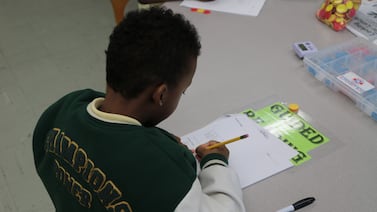Sign up for Chalkbeat New York’s free daily newsletter to keep up with NYC’s public schools.
On paper, New York City’s plan to eliminate the elementary grades of an under-enrolled Harlem K-8 school and merge its middle school grades with a more popular junior high across town isn’t a full school closure.
But to the families and staff at P.S./I.S. 76, where enrollment has shrunk from 476 to 287 over the last six years, it certainly feels like one.
“P.S. 76 is an institution. We’re not a merger,” said Marie Rosa, the school’s secretary, during a recent virtual hearing on the plan. “When you see something that needs to be fixed, you fix it. You don’t discard it.”
Plans like the one to merge P.S./I.S. 76 with Mott Hall II middle school in Morningside Heights are part of a strategy that New York City education officials have used with increasing frequency over the past year, according to a Chalkbeat analysis. New York City, like other districts across the country, is grappling with a yearslong enrollment decline and a growing number of tiny schools, which are more expensive to operate and more limited in what they can offer students.
Last year, the city approved 13 proposals to merge or remove grades from schools – the most of any year since at least 2018, according to a Chalkbeat review of six years of records covering dozens of meetings of the Panel for Educational Policy, which approves such proposals.
So far, the city’s acceleration of school mergers has managed to fly largely under the radar, for the most part avoiding the intense public backlash that accompanied many of the city’s school closure proposals in past years or the explosive debates that have cropped up in other parts of the country.
That may be in part because city officials haven’t laid out a citywide plan to consolidate small schools, instead leaving it to local superintendents to develop proposals that can pass muster in their communities.
Observers said it’s also possible the city’s strategy of leaning heavily on mergers rather than outright closures has also helped blunt some of the backlash.
Proponents argue mergers can feel less disruptive than simply closing a school and in some cases can create more racially and socioeconomically integrated schools.
But joining schools with disparate student bodies, cultures, and academic approaches comes with its own challenges. And for the school that loses its name and principal, the mergers often feel little different than a closure.
Whether the city will continue or accelerate the pace of mergers this school year — and how officials will navigate the community backlash — are critical and open questions for the nation’s largest system.
Shuttering schools can be politically perilous, and the areas of the city with the highest concentrations of under-enrolled schools — including Harlem, central Brooklyn and the Bronx — are critical parts of Mayor Eric Adams’ voting base at a time when he’s never been more politically vulnerable.
Education Department First Deputy Chancellor Dan Weisberg credited the city’s approach of leaning on district superintendents with helping get communities on board, and said he plans to stick with that playbook.
Proposals to consolidate schools are “not being generated top down. They really are coming from communities and superintendents,” he told Chalkbeat. “There will certainly be a number of others. How many? We’ll have to wait and see.”
However the city proceeds, the stakes are high for families, educators, and the school system at large. Losing access to a cherished neighborhood school can be devastating for its community. Many families appreciate the intimacy of small schools, and they can boost academic results.
Yet, sustaining hundreds of ultra-small schools comes with serious costs for both families and the district.
There are already some signs that the city may be in for more of a fight this year. A plan to merge P.S. 295 — an arts-focused elementary school in Park Slope that’s lost half its enrollment in recent years — with nearby P.S. 10 is on hold while district officials give the new administration at P.S. 295 time to win back enrollment, according to a letter from the principal obtained by Chalkbeat.
And officials decided on Friday to postpone the vote on the P.S./I.S. 76 merger from Oct. 30 to an unspecified later date because newly minted Chancellor Melissa Aviles-Ramos asked for more time to review the proposals, according to Education Department spokesperson Nathaniel Styer.
NYC grapples with a growing number of small schools
New York City’s K-12 public school enrollment fell by about 130,000 students, or 14%, since fall 2016, according to city data. As enrollment has declined citywide, the number of schools with fewer than 200 students has doubled, from 81 in 2016 to 190 last year, according to a Chalkbeat analysis.
And though enrollment stabilized last year thanks to an influx of migrant students, the School Construction Authority projects student numbers will fall by more than 200,000 students, or 26%, over the next decade due to a combination of lower birth rates and families exiting the city.
That means pressure will likely continue to build on the city to consolidate ultra-small schools.
Weisberg said the threshold at which a school becomes too small varies from school to school. Officials grow concerned when a school can’t staff classes with licensed teachers, offer extracurricular opportunities, or provide “advanced academic opportunities,” he added.
Some of the seeds of the current crisis were planted about two decades ago, when former Mayor Michael Bloomberg oversaw a sweeping effort to close struggling larger high schools and replace them with hundreds of smaller ones under the theory that smaller schools could deliver better results.
There’s evidence that smaller schools produced benefits, leading to higher graduation rates and college enrollment, though there is little research on how those schools are faring now.
“New York City’s small schools had a very large, consistent positive impact on students,” said Rebecca Unterman, of the research firm MDRC, who studied the effect of the small schools in the years after they opened.
Over the past six years, the city has passed 35 proposals to merge, close, or remove grades from schools, according to the Chalkbeat analysis. The vast majority were mergers, and only one was an outright closure. Roughly two-thirds of the affected schools were in Brooklyn or the Bronx, the two districts that have seen the largest enrollment declines in recent years.
A significant majority of schools affected by mergers or closures had a higher proportion of Black, Latino, and low-income students than the median school in the city, mirroring national trends.
Some of the recently merged schools are small high schools located in the same building, in a kind of reversal of the Bloomberg-era small schools movement.
“The idea of merging some of these schools together so they’re more sustainable in my opinion is fine,” said Tom Sheppard, a Bronx parent representative to the Panel for Educational Policy.
Eric Nadelstern, a former deputy chancellor under Bloomberg and one of the architects of the small school movement, disagrees with the city’s school merger strategy.
Mergers are politically appealing because they generate less pushback, but closures are the better choice because it can be harmful to combine schools that vary widely in quality and approach, he said.
Last year, a Brooklyn high school focused on training future firefighters and paramedics merged with one focused on civil rights, while Bronx Aerospace High School joined with the Bronx High School for Writing and Communication Arts.
“School cultures are different,” Nadelstern said. “The last thing you want is to take a couple hundred kids who have experienced failure in one school and send them wholesale to another school.
“Failed schools should close,” he added. “And one significant indicator of school failure is you can no longer attract kids.”
Harlem merger proposal raises thorny questions
The politics of school closures and mergers can be even more complicated at the elementary and middle school levels, where families are often fiercely attached to neighborhood schools.
Last year, P.S./I.S. 76 enrolled about 100 students in its middle school grades, while Mott Hall had nearly 400. Officials from Manhattan’s District 3, which spans the Upper West Side and parts of Harlem, said the merger plan has been in the works for about a year. It’s meant to address both the demand for a robust middle school option on the Harlem side of the district, while also finding a solution for a school that had become unsustainably small.
The plan would move Mott Hall, where roughly 77% of students are Black and Latino, 17% are white, and about two-thirds come from low-income families, from its current location in Morningside Heights to P.S./I.S. 76′s building on 121st Street in Harlem. P.S./I.S. 76 is currently 89% Black and Latino, 9% white, and almost all of its students come from low-income families.
Under the proposal, the merged Mott Hall II would expand to a 6-12 school, the high school portion of which would screen applicants based on criteria like grades.
Opening more screened high schools in communities that have historically had fewer of them was a policy priority of former schools Chancellor David Banks.
Kamar Samuels, the superintendent of Manhattan’s District 3, who has spearheaded several merger proposals, including the P.S./I.S. 76 plan, said he appreciates the fact that mergers keep communities of students and staff together, rather than dispersing them across a number of schools.
“The disruption is not as significant as it typically is with another intervention,” he told Chalkbeat.
Mott Hall II families who joined the virtual hearing earlier this week were largely supportive, despite some misgivings from families who would have longer commutes. Principal Marlon Lowe acknowledged the concerns of the P.S./I.S. 76 community, but assured them his school absorbed another one previously and would do it with “class, dignity, and respect.”
But P.S./I.S. 76 families and staff argued the district hasn’t done enough to help the school reverse its enrollment losses, and they said the merger would leave a hole in the community.
“I understand it’s financial,” said Rosa, the school secretary. “But it’s also displacing our families that think of P.S./I.S. 76 as a home and the center of the community.”
Michael Elsen-Rooney is a reporter for Chalkbeat New York, covering NYC public schools. Contact Michael at melsen-rooney@chalkbeat.org
Alex Zimmerman is a reporter for Chalkbeat New York, covering NYC public schools. Contact Alex at azimmerman@chalkbeat.org.
Kae Petrin is data and graphics reporter for Chalkbeat. Contact Kae at kpetrin@chalkbeat.org.






